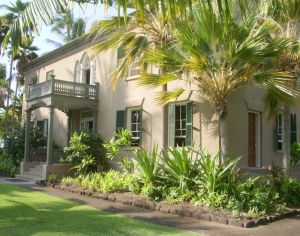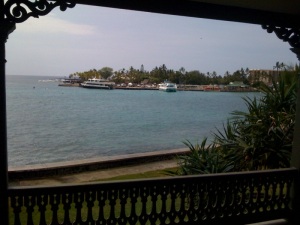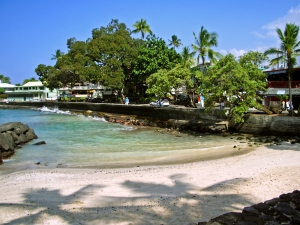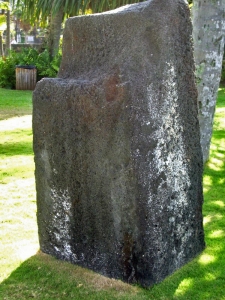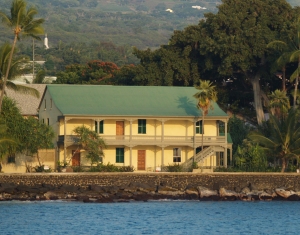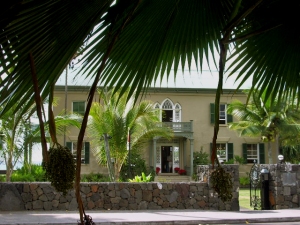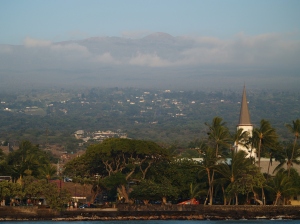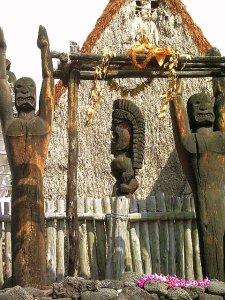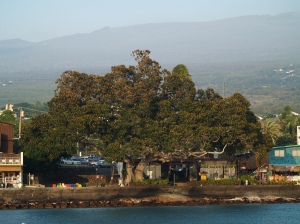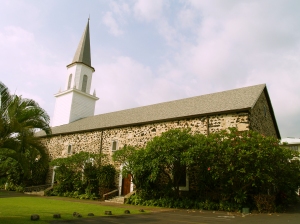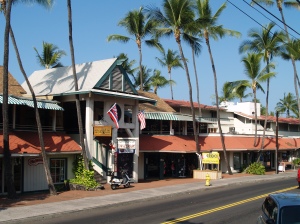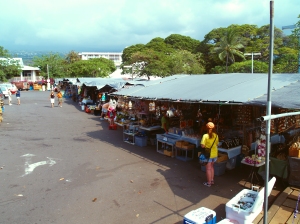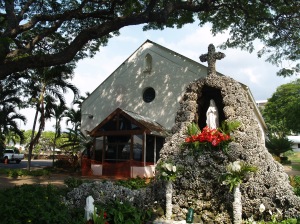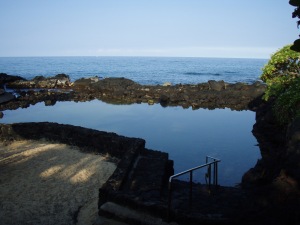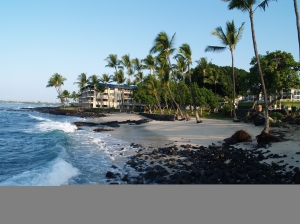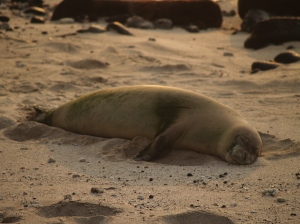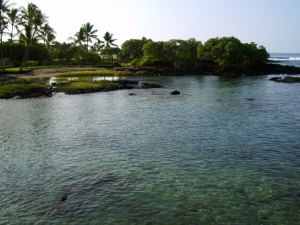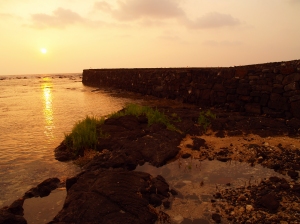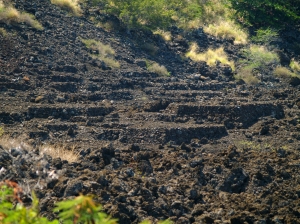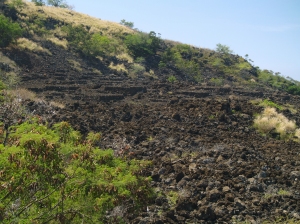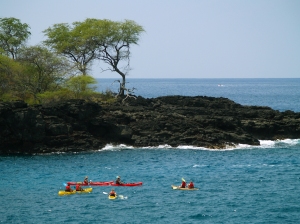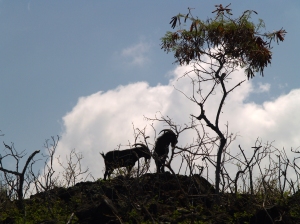Trip 4: Hawaii Volcanoes National Park and Lava Viewing Approximate minimum time start to finish (to see every site): 14 hours (return drive in the dark).
From Kona, connect to Highway 11 south 2 1/2 hours to Ka'u Desert Trail. A 40 minute round trip hike leads to footprints of ancient warriors who where caught in a sudden, ferocious eruption. Continue on Highway 11 to Hawai'i Volcanoes National Park. Park Rangers at the Visitor Center will have the latest lava information. Chain of Craters Road has numerous craters, tons of hiking trails and several breathtaking vistas for great photographs. Upon exiting the Park, continue to Kea'au and Highway 130 (food stop). Proceed to Pahoa and the junction to Highway 132 and Lava Trees State Park. Here trees were inundated with fast flowing lava. When the trees rotted, it left these Lava Trees. Then on to Highway 137, following the coast to Kalapana and a 20 minute hike to the lava viewing area at Waikupanaha. (Arrive about dusk for optimal viewing.) From Kalapana back to Kona is a 3 1/2 hour drive (after dark).
Leg 1) Start at north end of Keauhou Historic District on Ali’i Drive, head south on Ali’i Drive to jct with Kamehameha II Hwy; east on Kamehameha III to Hwy 11. Take Hwy 11 south to Ka’u Desert/Warrior Footprints Trail.
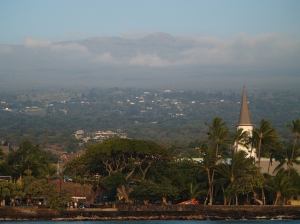
- Evening Light on Hualalai and Kailua Kona: Photo by Donnie MacGowan
Keauhou Historic District and Kona Coffee
For almost 400 years, temples and palaces along the Kona coastline served as a kind of "Rome of the Pacific", a great political, religious and cultural center in Polynesia, until the capital was moved to Honolulu in 1850 by Kamehameha III.
The most important, interesting and best preserved historical and cultural sites lie within the Keauhou Historic District, between Kahalu'u Beach Park in Kailua running south 6 miles to Kuamo'o Bay in Keauhou. The District contains perhaps a dozen fascinating sites that are easy to walk to, well maintained and quite interesting. To see the numerous fascinating and important archaeological sites in the Keauhou Historic District, it is necessary to park your car in the free parking at either Kahalu’u Beach Park or the Keauhou Beach Resort and explore on foot.
Just uphill from the Historic District is the Kona Coffee District. Hawaii is the only state in the union which produces coffee, and Kona coffee is perhaps the finest in the world. Over 2 millions pounds of coffee a year are produced on about 600, 2-3 acre farms; tours of coffee farms and roasteries are available.
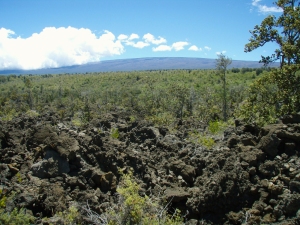
- Mauna Loa Rises Above the Ka'u Desert at Warriror Footprints: Photo by Donald B. MacGowan
Ka’u Desert Trail and Warrior Footprints, Hawai’i Volcanoes National Park
Just where Hawai’i Belt Road enters Hawaii Volcanoes National Park from the West, is a small parking strip that is the gateway to a host of wonders within the Ka’u Desert section of Hawaii Volcanoes National Park. Although eruptions here are generally characterized by leisurely outpouring of lava, it is not unknown for Kilauea to violently erupt in a blast of steam and ash. It is this ash that preserves some human footprints, believed to have been formed in 1790 when enemies of Kamehameha the Great were caught by one such massive, explosive eruption. Perhaps as many as 400 men died in this eruption. An emergency phone is available here; there are no other services. Do not venture from your car here without carrying water.
Leg 2) Continue south on Hwy 11 to Hawaii Volcanoes National Park Entrance and jct with Crater Rim Drive; Crater Rim Drive west to Kilauea Visitor’s Center to Jagger Museum, then back around Crater Rim Drive to Kilauea Iki Crater.
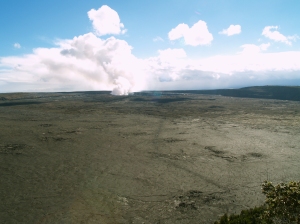
- Kilauea Crater and the Current Halema'uma'u Eruption As Seen from Waldron Ledge, Hawaii Volcanoes National Park: Photo by Donnie MacGowan
Hawai’i Volcanoes National Park
Hawai’i Volcanoes National Park is a magical, spiritual, wondrous, strange and beautiful place comprised of great contrasts and contradictions: dry as dust desert to teeming tropical jungle; frigid sub-arctic wasteland to steaming black sand beaches to rivers of flowing lava.
The star attractions in the Park are a pair of active volcanoes; Mauna Loa is the largest mountain on earth and Kilauea is most active volcano on earth. However, there are numerous other wonders from lava tubes to crawl down, black sand beaches with sea turtles to watch, mysterious petroglyph fields to explore, tropical jungles to hike through, endangered bird species to find, happy-face spiders to amuse and an otherworldly volcanic landscape so fresh it’s still steaming.
Hawaii Volcanoes National Park is open 24 hours a day, 365 days a year. During daylight hours, an access fee is charged. The Visitor Center has a 24-hour information line at 808.985.7017 and there is a 24-hour eruption hotline at 808.985.6000. Within the Park tune to A.M. radio 530 for continuous information broadcast. There tourist items available for sale and one restaurant and in the park, however generally shopping, restaurants and gasoline are only available in the nearby village of Volcano.

- Kilauea Visitors Center at Hawaii Volcanoes National Park: Photo by Kilgore Trout
Kilauea Visitor Center
Newly remodeled and updated, the Kilauea Visitor’s Center is an outstanding resource of information on Hawaii’s volcanoes and the National Park; the not-to-be-missed first stop in the park you must make. The Center is run by enthusiastic and knowledgeable staff that has the most up-to-date information on viewing the eruption, hiking and camping, bird watching, stargazing and just about any other topic of interest to Park visitors.
Available for sale in the Center are maps, guidebooks, books and videos about the volcanoes, Hawai’iana, history, plants and every topic you can imagine pertinent to the Park, even souvenirs. There are free brochures and pamphlets on various trails, attractions, hiking safety and lava viewing hazards and precautions. The Visitor Center is open daily from 7:45 a.m. to 5 p.m.; there are public restrooms, water and pay phones available. Starting at 9 a.m. and showing every hour on the hour is a 20 minute informative movie about the Park; the film changes from time to time, but always contains spectacular footage of eruptions, information on volcanology and the natural and human history of the Park.
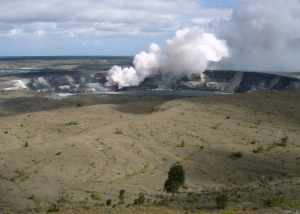
- View of Halema'uma'u from Jagger Museum, HVNP: Photo by Donald MacGowan
Jagger Museum and Hawai’i Volcano Observatory
Famed for its fabulous views of Mauna Loa and Kilauea as much as for its interesting exhibits, The Jagger Museum (named for geologist Thomas A. Jagger) is open daily from 8:30a.m. to 5:00p.m. Exhibits include murals by Herb Kawainui Kane, seismograph charts of eruptions and earthquakes, geological displays and display about the natural and human history of the Park.
When entering the parking lot of the Museum/Observatory, be especially careful of the Federally-protected Hawaii Goose, the Nene, who seem to congregate here. The Nene is the State Bird of Hawai’i, and this parking lot and its surrounding area constitute one of the best places for viewing them.
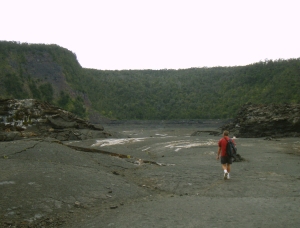
- Frank Burgess On Kilauea Iki Trail: Photo by Donnie MacGowan
Kilauea Iki Trail
Perhaps the finest short day hike in the park, a four-mile, 2-3 hour trip down into, across and back out of Kilauea Iki Crater gives one an intimate feel for volcanoes, Hawaiian-Style. Along one side, thick fern and ohi’a forest skirts along the rim and on the other, lush tropical rainforest crowds to the very brink of the crater; bleak volcanic desert lines the crater walls and covers the floor. The start and finish of the hike are along well marked, wide trails. The remainder is an easily followed, well marked trail with stone ahu (cairns) over the crater floor. As always when hiking in the Park, it is wise to avoid the noonday sun, and to remember that afternoon showers are common, especially near where this hike meets the crater rim.
Leg 3) Crater Rim Drive to intersection with Chain of Craters Road; Chain of Craters Road to End of Road.
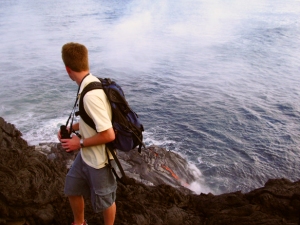
- Hiking from the End of Chain of Craters Road to the Lava Ocean Entry at La'epuki: Photo by Donald MacGowan
End of Chain of Craters Road
The end of Chain of Craters Road is currently at the 19 mile marker near the Holei Sea Arch. This is where the road was cut off by flowing lava and destroyed the 2 million dollar visitor center. When the lava is near the road, one can walk right up to it. There are displays about the volcano and natural history of the area, as well as a wealth of information on hiking to, and viewing, the lava, available here.
Hiking all the way out to the active flows is one of the most spiritually rewarding, awe-inspiring, curiosity quenching and amazing things one can do anywhere in the world—but it is neither for the physically unfit nor the meek of spirit. It is a long, hot hike (currently seven miles) over broken ground and glass-sharp rocks; the heat from the volcano is savage; the weather, if clear, is sweltering…frequent squalls blow in off the ocean and the rain and wind can get pretty wild out on the lava plain where there is absolutely no cover or shelter to protect you. No water or shade is available anywhere along the hike.
Leg 4) Follow Chain of Craters Road back uphill to Crater Rim Drive, follow Crater Rim Drive back to Park Entrance and then to Hwy 11. Go east on Hwy 11 to jct with Hwy 130 at Kea’au; take Hwy 130 south to Pahoa.
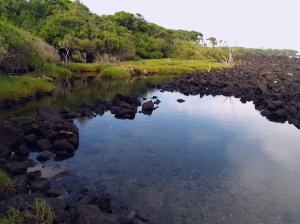
- In Hawaiian, "Puna" means "Spring" and Puna District in General, and the Area Around Pahoa in Particular, Is Dotted With Hot, Warm and Cold Springs: Photo by Donnie MacGowan
Puna District and Pahoa Town
Uncrowded, off the beaten track and largely undiscovered by tourists, Puna District is a magnificent wonderland; from incredible tree-tunneled roads, geothermal fields of steam vents, lovely beach parks, hot ponds, hikes on raw lava flows and jungle trails, and unequaled snorkeling, the land cries out for the visitor to explore a little bit.
At the center of Puna is Pahoa Town; wild, untamed and even a bit unruly, with its false-front, western-style buildings and raised wooden sidewalks, Pahoa looks more like it belongs in Wyoming. But Wild West isn’t the only subculture evident here…tie-dye banners and the general “flower-power” ambience some businesses and citizens lend Pahoa give it a decidedly “’60’s” feel.
It has been said of Pahoa that if it weren’t for counter-cultural influences, it would have no cultural influences at all. The charm and allure of this way of living is evident when you consider that the region around Pahoa is the fastest growing portion of the island. Pahoa has some of the best restaurants on the island, THE best natural foods store and a great public pool.
Leg 5) At Pahoa, get on Hwy 132 to Lava Trees State Park.
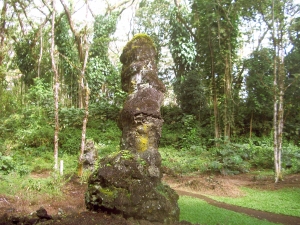
- Lava Trees State Park: Photo by Donnie MacGowan
Lava Trees State Monument
Under a lacey canopy of monkeypod trees, casts of ohi'a trees stand as monuments to a fast-moving pahoehoe lava flow that passed through here in 1790. When the lava hit the water-saturated ohi'a trees, it cooled and began to congeal around them. The original ohi'a trees burned away but the quickly cooled lava around them stands here today, hollow, with imprints of the tree bark inside. Lava Trees Park offers trails to hike and a restful, bird-filled jungle to sit and listen to. You can spend between 20 minutes to an hour wandering the trails, here, exploring and discovering. Be careful, however, the area is riddled with hidden cracks in the ground which can make exploring hazardous. You may wish to avail yourself of the restrooms here; they are the last public facilities for some distance.
Leg 6) From lava Trees State Park take Hwy 132 to jct with Hwy 137 at Kapoho; take Hwy 137 southwest to Ahalanui Pond then to Kaimu Black Sand Beach and Kalapana Disaster of 1990.
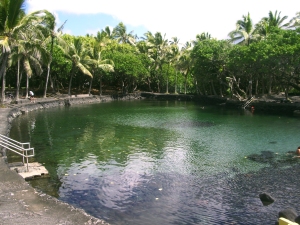
- Ahalanui Hot Pond: Photo by Donald MacGowan
Ahalanui Pond
Also called “Secrets Beach”, this spring and ocean-fed, manmade pool was initially constructed when the springs ran chilly cold. Eruptions in Puna during the ‘50s and 60’s reworked the subterranean waterworks and now the springs run hot and the pool is a comfortably warm 90-95 degrees. The open connection to the ocean, keeps the water fresh. With the gentle aloha breezes, swaying palms and surf whooshing against the, it can be really hard to drag oneself out. Soak for a while. Picnic tables, pavilions, pit barbecues, showers, lawns and all the pleasantries of a civilized park are available at Ahalanui Pond. Leave no valuables in your car and be vigilant if you stay soaking here, after dark.
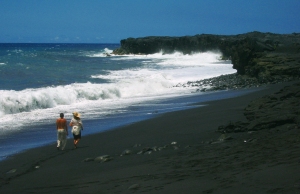
- Kaimu Beach near Kalapana, Puna Hawaii: Photo by Donnie MacGowan
Kalapana Disaster of 1990/Kaimu Black Sand Beach
In 1990 the volcano goddess Pele determined it was time for some serious housecleaning in Puna. Lava flows from Kilauea’s East Rift engulfed the villages of Royal Gardens, Kaimu and Kalapana, destroying virtually everything.
Buried were a centuries old fishing village and a world famous black sand beach. When the lava came, it wiped out not just material possessions; it wiped out a way of life and a landscape cherished by generations. The Big Island's newest black sand beach, Kaimu Beach, is a lovely if barren crescent of sand at the end of an unforgiving expanse of lava from the 1990 flows. The trail to the new black sand beach is marked with hundreds of young palms, numerous lava casts which include palms, pandanas fruit and even some fish that were caught in tide pools.
From the lava hillocks along the trail you can get nice views of the eruption plume at Pu’u O’o, up on the flank of Kilauea, as well as the steam clouds down a few miles along the coast where the lava enters the sea. Restrooms and fast food are available at the end of the road.
Leg 7) From Kalapana, take Hwy130 (Ahia Road) just a tweak to the jct with old HWY 130; go west on old the highway to Waikupanaha Lava Viewing.
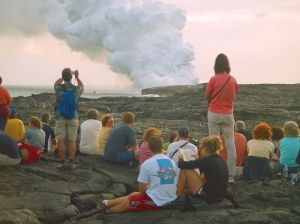
- Lava Viewing At Waikupanaha, Puna Hawaii: Photo by Donald MacGowan
Lava Viewing Near Kalapana
Nowhere else can you see lava flowing from a volcano into the sea; no Big Island visit is complete without seeing this awe-inspiring show. Currently lava is only flowing into the sea outside the Park. Drive south on Highway 130 through Pahoa to the 20 mile marker and take the right branch about two miles to the parking area. Port-a-potties are available here. The road is open from 2 p.m. until 10; no cars allowed in after 8. Lava viewing information is available from Hawaii County at 808.961.8093; check conditions before you go.
The easy trail, a 20 minute stroll to the viewing area, is well-marked. The viewing varies as lava flows nearer or farther from the trail. Viewing is best at dusk so bring flashlights for the hike out. Take close-toed walking shoes and a hat, long pants and long-sleeved shirt, at least 2 liters of water and sun block and a rain jacket and camera. Remember food and gas are not available anywhere nearby after dark, so fill up BEFORE you park, bring snacks and drinks. There are port-a-potties available at the parking lot.
Leg 8) Return to Hwy 130; Hwy 130 north through Pahoa to Kea’au and jct with Hwy 11. Hwy 11 west to Kailua Kona. Take Hwy 11 west to Kailua Kona.
For more information on visiting Hawaii in general and touring the Big Island in particular, please visit www.touruidehawaii.com and www.lovingthebigisland.wordpress.com. For information about the author, please go here.

- Sunset Over Oneoneo Bay, Kailua Kona Hawaii: Photo by Donald MacGowan
